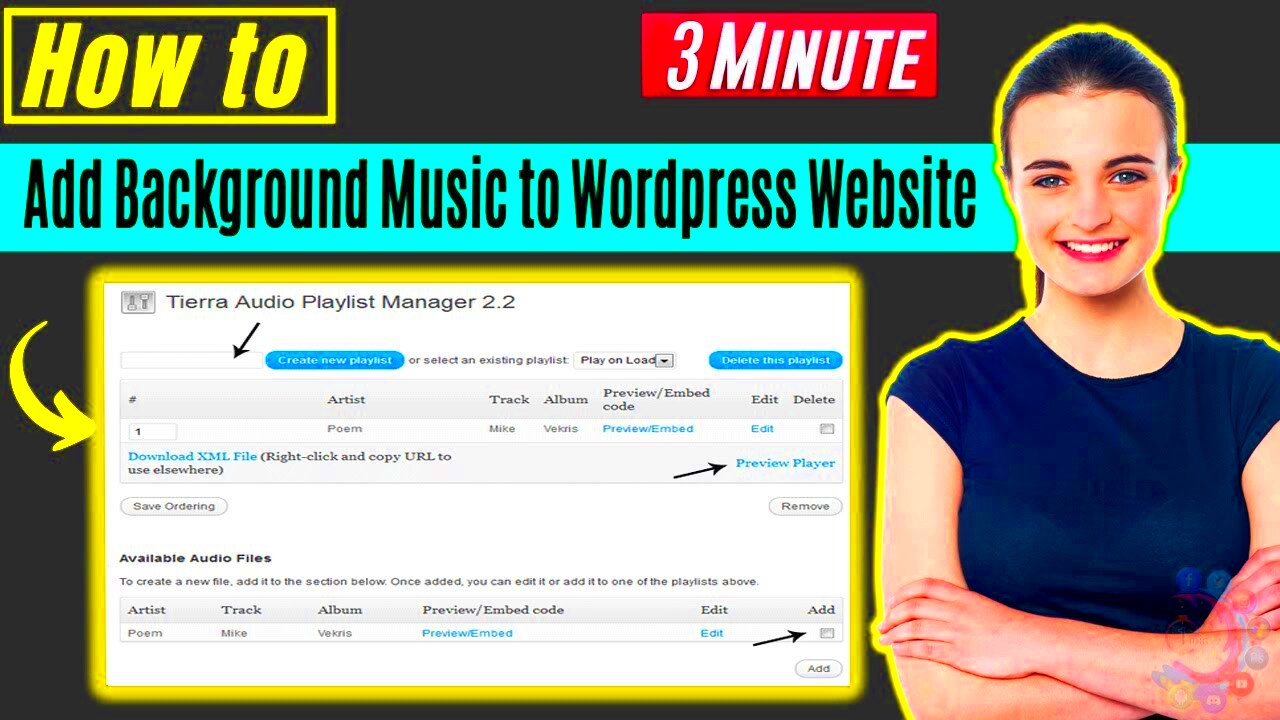When it comes to web design, the visual appeal often takes center stage. However, incorporating background music into your WordPress homepage can elevate the user experience to a whole new level. Imagine walking into a cozy cafe where soft music plays, instantly setting a relaxing mood—this is the kind of ambiance background music can create for your website visitors. In this post, we’ll explore why background music can be a crucial element for your homepage and how to seamlessly integrate it into your WordPress site.
Benefits of Adding Background Music to Your WordPress Homepage

Adding background music to your WordPress homepage might seem like a fun idea, but it comes with serious benefits. Let’s delve into some of the most compelling reasons to consider this feature:
- Enhanced User Engagement: Background music can captivate visitors from the moment they land on your site. It keeps them around longer, encouraging them to explore more of what you offer.
- Emotional Connection: Music has the power to evoke emotions. Choose a track that resonates with your brand, and you’ll create an emotional bond with your audience, making your website memorable.
- Improved Brand Identity: The right background music can define your brand’s personality. For a spa, soft instrumental music sets a tranquil vibe; for an energetic startup, an upbeat tune could energize the atmosphere.
- Setting the Mood: Music can enhance the mood you want to convey. Whether it’s serenity, excitement, or nostalgia, a carefully selected track can help articulate your message.
- Unique User Experience: In a crowded online space, a unique auditory element can make your site stand out from the competition, offering visitors a memorable experience they won’t find elsewhere.
Overall, integrating background music into your WordPress homepage is not just about having a little fun; it’s a strategic choice that adds value to your visitor’s experience!
Choosing the Right Music for Your Website

Choosing the right music for your WordPress website is a crucial step that can significantly enhance the overall user experience. Think of background music as the emotional undercurrent of your site; it sets the tone and can either captivate your audience or drive them away. First, consider your audience and the type of content you are providing. For instance:
- Corporate Websites: Opt for instrumental music that reflects professionalism, like soft piano or light jazz.
- Creative Portfolios: You might choose something more eclectic or energetic to showcase your personality.
- Blogs: Depending on your niche, you might want upbeat tracks for lifestyle blogs or calming soundscapes for wellness sites.
Next, always keep copyright in mind. Using royalty-free music or tracks with a Creative Commons license can save you from legal troubles down the road. Websites like Bensound and FreePD offer vast libraries of free music suitable for various uses.
Also, think about the volume and length of the track. The music shouldn’t overpower your content; it should complement it. A good rule of thumb is to choose tracks that can loop seamlessly and are between 1 to 3 minutes long for a smoother user experience. Lastly, don’t forget to ask for feedback! Sometimes, a fresh set of ears can catch things you might miss.
Methods for Integrating Background Music in WordPress

Integrating background music into your WordPress site can seem daunting, but it’s actually quite straightforward. Below, we break down some popular methods so you can choose what works best for your site:
| Method | Description |
|---|---|
| Using a Plugin | Plugins like MP3 Music Player by Sonaar or Compact WP Audio Player allow you to easily add music without any coding. Just install the plugin, upload your track, and you’re good to go! |
| Embedding from Streaming Services | You can embed tracks from platforms like SoundCloud or Spotify directly to your site. Just get the embed code from the service and paste it into your WordPress editor. |
| Custom Code | If you’re comfortable with HTML, you can manually embed an audio tag in the HTML block of your post or page. This gives you complete control over the audio settings. |
Regardless of the method you choose, always remember to include a mute button or a way for users to control the audio. This consideration enhances user experience and makes your site feel more professional. Happy music creating!
Using Plugins for Background Music Integration
Integrating background music into your WordPress homepage can elevate the user experience, making it more engaging and memorable. One of the easiest and most efficient ways to do this is through plugins. WordPress offers a plethora of plugins specifically designed for audio management, enabling you to add background music with just a few clicks. Here’s how to make the most out of these tools:
- Search for Audio Plugins: Start by navigating to the WordPress Plugin Directory. Search terms like “background music,” “audio player,” or “music integration” can yield a treasure trove of options. Popular choices include Blubrry PowerPress, Compact WP Audio Player, and MP3 Music Player by Sonaar.
- Install and Activate: Once you’ve chosen a plugin, installing it is fairly straightforward. Click on “Install” and then “Activate.” Most plugins will guide you through a configuration wizard upon activation.
- Customize Settings: After activation, head to the plugin’s settings area. Here, you can choose music tracks, adjust volume levels, set autoplay features, select whether it plays in a loop, and more. Make sure to preview the changes to find the perfect balance!
- Embed Music on Your Homepage: Many plugins provide shortcode options that you can easily insert into your homepage layout. Just copy the shortcode and paste it where you want the music to play.
With plugins, you don’t need to be a tech whiz to integrate seamless background music into your WordPress homepage. Just remember to consider the user experience—too much music can be overwhelming! So, choose wisely.
Embedding Audio Using Code
If you’re a bit more tech-savvy, embedding audio using code is a fantastic way to customize the music experience on your WordPress homepage. This method provides you with greater control over how your audio is presented and played. Here’s a step-by-step guide to get you started:
- Upload Your Audio File: First, upload your audio file (like MP3) to the WordPress media library. Navigate to Media > Add New and either drag and drop your file or click to select it.
- Get the Audio URL: Once uploaded, locate the media file in your library. Click on it and copy the URL provided on the right side of the screen. This URL is what you’ll use to embed the music.
- Embedding the Audio Code: Next, switch to the HTML editor in the page or post where you want the music. Use the HTML5 `
<audio controls autoplay loop> <source src="YOUR_AUDIO_URL_HERE.mp3" type="audio/mpeg"> Your browser does not support the audio tag.</audio>Replace YOUR_AUDIO_URL_HERE.mp3 with the URL you copied. The controls attribute provides user-friendly options for playback, while autoplay and loop enhance the background experience.
With coding, you can customize the `
7. Setting Up Automatic Play vs. User Control
When it comes to integrating background music into your WordPress homepage, one of the first considerations you’ll face is whether to set it to play automatically or give users control. Both options have their pros and cons, and the choice often depends on the kind of experience you want to create for your visitors.
Automatic Play: This option allows background music to start playing as soon as users land on your site. It can be a great way to enhance the mood and energy of your homepage, immediately grabbing visitors’ attention. However, automatic play can also lead to frustrations, especially if users were not expecting sound. Think about the scenario—if someone is in a quiet environment or at work, suddenly being hit with music could drive them away from your site.
User Control: Allowing users to control the music offers a more tailored experience. They can choose to press play or pause, creating a sense of engagement. This option is generally more favored, particularly in terms of user experience. If users don’t want music, they can easily stop it, preventing distraction and annoyance.
In deciding between these options, consider adding a toggle button or volume control in a visible area. This can significantly enhance the user experience, letting visitors feel more in control of what they’re experiencing. Here’s a quick summary of the two approaches:
- Automatic Play:
- Pros: Sets the mood quickly, can enhance ambiance.
- Cons: May annoy users, can distract from content.
- User Control:
- Pros: Enhances user experience, allows choice.
- Cons: Might not create the instant atmosphere you desire.
8. Considerations for User Experience and Accessibility
Integrating background music on your WordPress homepage isn’t just about aesthetics; it’s essential to think about the user experience and accessibility. It’s crucial that the musical element supports your content rather than detracts from it. Here are some key considerations when adding music to your site:
Volume Control: Providing a volume control is vital. This allows users to adjust the volume to their liking or mute it altogether. Music that’s too loud can overshadow important content and attempts to engage users.
Pause/Play Buttons: Like volume control, offering a clear and easily accessible pause/play button is necessary. Users should have the freedom to choose when they want to listen, reinforcing a sense of control over their navigation experience.
Device Compatibility: Ensure that the background music functionality works seamlessly across all devices, including mobile phones, tablets, and desktops. Many users access websites on the go, and automatic audio can disrupt their activities.
Accessibility: Just as with any other content, ensuring that your music integration is accessible is crucial. This could mean providing text alternatives or descriptions for users who may not be able to hear the music but want to understand the experience you’re trying to convey.
Lastly, always think about the context in which your website will be used. For example, if you run a business site, ambient music might distract from your key messages. On the other hand, if you have a creative portfolio, music can enhance the overall vibe. Stay considerate, and make user experience and accessibility your top priority.
9. Testing and Optimizing the Background Music Feature
Now that you’ve successfully integrated background music into your WordPress homepage, it’s time to ensure it’s working smoothly and enhancing the user experience instead of detracting from it. Testing and optimization are vital steps in this process, helping you fine-tune your background music to fit your audience’s preferences and the overall vibe of your website.
First, embark on some extensive testing to assess functionality. Here’s a quick checklist to guide you:
- Cross-Browser Compatibility: Ensure that the music feature works seamlessly across all major browsers (Chrome, Firefox, Safari, etc.).
- Mobile Responsiveness: Check that the music plays correctly on mobile devices. Many users access websites from their phones, so your music should be easily accessible and not overly loud or disruptive.
- Volume Control: Make it easy for users to adjust the volume or mute the music completely. Consider using a clear, user-friendly control that integrates well with your site’s design.
Next, gather user feedback. You can achieve this by:
- Sending out surveys.
- Conducting A/B tests for different music choices or styles.
- Observing user engagement metrics, such as time spent on the page or bounce rates.
Finally, be ready to make adjustments. Whether it’s changing the music track to match your audience’s tastes or modifying playback settings, continual optimization will help maintain a pleasant atmosphere that encourages visitors to return.
10. Conclusion and Final Thoughts
Integrating background music into your WordPress homepage can significantly enrich the user experience. It evokes emotions, sets a welcoming tone, and enhances the overall aesthetic of your site. However, it’s essential to approach this feature with care. When done right, music can transform your website from a simple informational hub into an engaging, immersive platform.
Remember the key points we discussed throughout this post:
- Choosing the Right Music: Ensure the soundtrack aligns with your brand and audience preferences.
- Technical Setup: Utilize plugins judiciously to embed music effectively without compromising site performance.
- User Control: Allow visitors the freedom to play, pause, or adjust the music—this can make or break their experience.
- Testing and Feedback: Regularly test and optimize the music feature based on user interactions and feedback.
In conclusion, tread carefully when adding background music to your site. While it can positively influence how users perceive your brand, ensuring it enhances rather than hinders the experience is crucial. If executed thoughtfully, background music can be just the touch your WordPress homepage needs to leave a lasting impression.



